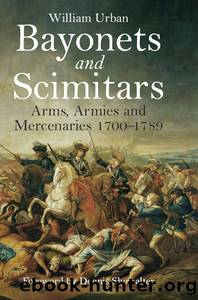Bayonets and Scimitars by William Urban

Author:William Urban
Language: eng
Format: epub
Tags: HISTORY / Modern / 18th Century
ISBN: 9781473829718
Publisher: Pen & Sword Books
Published: 2013-08-06T16:00:00+00:00
War in the Netherlands
In the spring of 1745 Maurice invaded the Austrian Netherlands, striking before Austrian reinforcements could reach the scene of combat. He was again opposed by Cumberland, whose imagination was as limited as his concept of warfare was outdated. Maurice deceived his enemy until he could pounce suddenly on Tournai, surrounding its Dutch garrison. Knowing that Cumberland would have to come to the rescue, he set a trap at Fontenoy, a position much like that of Malplaquet, only more sophisticated. Maurice had spent years meditating on Villar’s mistakes, writing out his conclusions in Memoirs on the Art of War. He put these into practice now – instead of digging trenches that became deathtraps if the attackers swarmed over them, thrusting their bayonets down, he constructed log barriers; he also built five redoubts that could fire into the flanks and rear of advancing troops; and he had much larger cavalry forces available. Alas, he also had the king and his girlfriends, and numerous civilian military ‘experts’ to deal with. On the other hand, Louis XV ordered his royal relatives not to give any orders themselves, but to obey those of Marshal de Saxe.3
British courage almost overcame every obstacle Maurice had devised. When Cumberland’s attacks on the flanks failed, instead of bringing up his artillery, he sent his British troops at the French centre. The crossfire was terrible and the cannon fire worse, but redcoats kept coming on. They were funnelled by the terrain into an ever more narrow killing ground, but once they reached the blue-coated French Guard and the red-coated Swiss, they blew their enemies’ front ranks apart and sent the rear ranks into wild flight. Only desperate counterattacks by the Irish ‘Wild Geese’, the Swiss Guard and the Household Cavalry saved the day.
Louis XV was appalled at the bloodshed, but Maurice, despite the terrible pain from his disease, simply told his majesty that this was what war was really like. Seven thousand or more Frenchmen had fallen, and more than ten thousand in the allied army. That made it, as far as Louis XV could see, a splendid victory; it had its frightening moments, but it provided anecdotes to enliven many a future conversation. Maurice went on to capture Tournai, then Ghent, and in the course of the summer, several more fortresses in the Austrian Netherlands. It helped that Cumberland was called home with the cream of his army to deal with the Jacobite rising in Scotland – the campaign that culminated in the battle at Culloden.
The allies in the Netherlands – Britain and Holland, now reinforced by the Austrians – decided that a new commander was needed. This was the unlucky Charles of Lorraine, Maria Theresa’s brother-in-law twice over, whose fate was usually to lose against Frederick II of Prussia. Charles did much better through the summer of 1746, but that was partly because Maurice was handicapped by intrigues at court, disobedience by his officers and his own poor health. In October the awkward position of
Download
This site does not store any files on its server. We only index and link to content provided by other sites. Please contact the content providers to delete copyright contents if any and email us, we'll remove relevant links or contents immediately.
| Arms Control | Diplomacy |
| Security | Trades & Tariffs |
| Treaties | African |
| Asian | Australian & Oceanian |
| Canadian | Caribbean & Latin American |
| European | Middle Eastern |
| Russian & Former Soviet Union |
The Secret History by Donna Tartt(16606)
The Social Justice Warrior Handbook by Lisa De Pasquale(11485)
Thirteen Reasons Why by Jay Asher(7779)
This Is How You Lose Her by Junot Diaz(5752)
Weapons of Math Destruction by Cathy O'Neil(5027)
Zero to One by Peter Thiel(4815)
The Myth of the Strong Leader by Archie Brown(4785)
Promise Me, Dad by Joe Biden(4439)
Stone's Rules by Roger Stone(4410)
Beartown by Fredrik Backman(4399)
How Democracies Die by Steven Levitsky & Daniel Ziblatt(4391)
The Fire Next Time by James Baldwin(4336)
100 Deadly Skills by Clint Emerson(4070)
A Higher Loyalty: Truth, Lies, and Leadership by James Comey(4024)
Rise and Kill First by Ronen Bergman(4008)
The David Icke Guide to the Global Conspiracy (and how to end it) by David Icke(3875)
The Farm by Tom Rob Smith(3869)
Secrecy World by Jake Bernstein(3773)
The Doomsday Machine by Daniel Ellsberg(3725)
